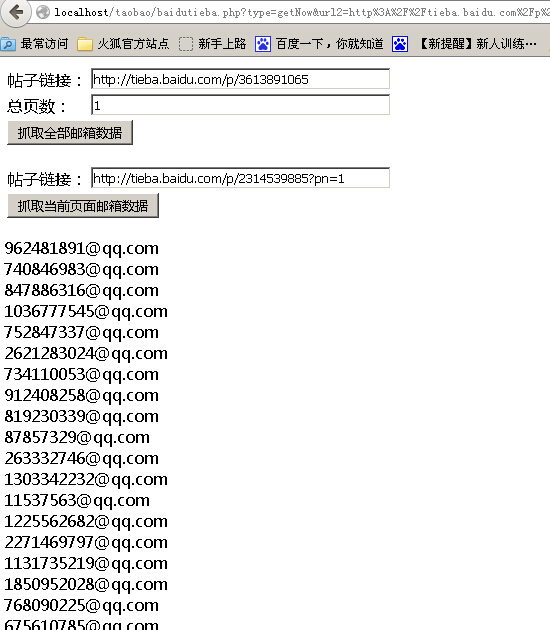PHP网页抓取之抓取百度贴吧邮箱数据代码分享
百度贴吧大家都经常逛,去逛百度贴吧的时候,经常会看到楼主分享一些资源,要求留下邮箱,楼主才给发。
对于一个热门的帖子,留下的邮箱数量是非常多的,楼主需要一个一个的去复制那些回复的邮箱,然后再粘贴发送邮件,不是被折磨死就是被累死。无聊至极写了一个抓取百度贴吧邮箱数据的程序,需要的拿走。
程序实现了一键抓取帖子全部邮箱和分页抓取邮箱两个功能,界面懒得做了,效果如下:

老规矩,直接贴源码
<?php
$url2="";
$page="";
if($_GET['url2']==""){
$url2="http://tieba.baidu.com/p/2314539885?pn=1";
}else{
$url2=$_GET['url2'];
}
if($_GET['page']==""){
$page="1";
}else{
$page=$_GET['page'];
}
?>
<form action="" method="get">
<input type="hidden" value="getAll" name="type" />
<table>
<tr>
<td>帖子链接:</td><td><input type="text" name="url" value="http://tieba.baidu.com/p/2314539885" style="width:300px;" /></td>
</tr>
<tr>
<td>总页数:</td><td><input type="text" name="page" style="width:300px;" value="<?php echo $page;?>" /></td>
</tr>
<tr>
<td colspan=2><input type="submit" value="抓取全部邮箱数据" /></td>
</tr>
</table>
</form>
<form action="" method="get">
<input type="hidden" value="getNow" name="type" />
<table>
<tr>
<td>帖子链接:</td><td><input type="text" name="url2" value="<?php echo $url2;?>" style="width:300px;" /></td>
</tr>
<tr>
<td colspan=2><input type="submit" value="抓取当前页面邮箱数据" /></td>
</tr>
</table>
</form>
<?php
if($_GET['type']!=""){
$counts=0;
if($_GET['type']=="getAll"){
$pages=$_GET['page'];
$url = $_GET['url'];
for($i=0;$i<$pages;$i++){
$ch2 = curl_init();
curl_setopt($ch2, CURLOPT_URL, $url);
curl_setopt($ch2, CURLOPT_FOLLOWLOCATION, TRUE);
curl_setopt($ch2, CURLOPT_SSL_VERIFYHOST, FALSE);
curl_setopt($ch2, CURLOPT_SSL_VERIFYPEER, false);
curl_setopt($ch2, CURLOPT_RETURNTRANSFER, TRUE);
$texts = curl_exec($ch2);
curl_close($ch2);
$dat=getEmail($texts);
for($j=0;$j<count($dat);$j++){
echo $dat[$j]."<br />";
$counts++;
}
}
}else if($_GET['type']=="getNow"){
$url = $_GET['url2'];
$ch2 = curl_init();
curl_setopt($ch2, CURLOPT_URL, $url);
curl_setopt($ch2, CURLOPT_FOLLOWLOCATION, TRUE);
curl_setopt($ch2, CURLOPT_SSL_VERIFYHOST, FALSE);
curl_setopt($ch2, CURLOPT_SSL_VERIFYPEER, false);
curl_setopt($ch2, CURLOPT_RETURNTRANSFER, TRUE);
$texts = curl_exec($ch2);
curl_close($ch2);
$dat=getEmail($texts);
for($i=0;$i<count($dat);$i++){
echo $dat[$i]."<br />";
$counts++;
}
}
echo '<h2 id="共采集到数据-counts-条">共采集到数据:'.$counts.'条</h2>';
}
function getEmail($str){
$pattern = "/([a-z0-9\-_\.]+@[a-z0-9]+\.[a-z0-9\-_\.]+)/";
preg_match_all($pattern,$str,$emailArr);
return $emailArr[0];
}
?>
Hot AI Tools

Undresser.AI Undress
AI-powered app for creating realistic nude photos

AI Clothes Remover
Online AI tool for removing clothes from photos.

Undress AI Tool
Undress images for free

Clothoff.io
AI clothes remover

AI Hentai Generator
Generate AI Hentai for free.

Hot Article

Hot Tools

Notepad++7.3.1
Easy-to-use and free code editor

SublimeText3 Chinese version
Chinese version, very easy to use

Zend Studio 13.0.1
Powerful PHP integrated development environment

Dreamweaver CS6
Visual web development tools

SublimeText3 Mac version
God-level code editing software (SublimeText3)

Hot Topics
 1377
1377
 52
52
 How to solve the permissions problem encountered when viewing Python version in Linux terminal?
Apr 01, 2025 pm 05:09 PM
How to solve the permissions problem encountered when viewing Python version in Linux terminal?
Apr 01, 2025 pm 05:09 PM
Solution to permission issues when viewing Python version in Linux terminal When you try to view Python version in Linux terminal, enter python...
 How to efficiently copy the entire column of one DataFrame into another DataFrame with different structures in Python?
Apr 01, 2025 pm 11:15 PM
How to efficiently copy the entire column of one DataFrame into another DataFrame with different structures in Python?
Apr 01, 2025 pm 11:15 PM
When using Python's pandas library, how to copy whole columns between two DataFrames with different structures is a common problem. Suppose we have two Dats...
 How to teach computer novice programming basics in project and problem-driven methods within 10 hours?
Apr 02, 2025 am 07:18 AM
How to teach computer novice programming basics in project and problem-driven methods within 10 hours?
Apr 02, 2025 am 07:18 AM
How to teach computer novice programming basics within 10 hours? If you only have 10 hours to teach computer novice some programming knowledge, what would you choose to teach...
 How does Uvicorn continuously listen for HTTP requests without serving_forever()?
Apr 01, 2025 pm 10:51 PM
How does Uvicorn continuously listen for HTTP requests without serving_forever()?
Apr 01, 2025 pm 10:51 PM
How does Uvicorn continuously listen for HTTP requests? Uvicorn is a lightweight web server based on ASGI. One of its core functions is to listen for HTTP requests and proceed...
 How to dynamically create an object through a string and call its methods in Python?
Apr 01, 2025 pm 11:18 PM
How to dynamically create an object through a string and call its methods in Python?
Apr 01, 2025 pm 11:18 PM
In Python, how to dynamically create an object through a string and call its methods? This is a common programming requirement, especially if it needs to be configured or run...
 What are some popular Python libraries and their uses?
Mar 21, 2025 pm 06:46 PM
What are some popular Python libraries and their uses?
Mar 21, 2025 pm 06:46 PM
The article discusses popular Python libraries like NumPy, Pandas, Matplotlib, Scikit-learn, TensorFlow, Django, Flask, and Requests, detailing their uses in scientific computing, data analysis, visualization, machine learning, web development, and H
 How to avoid being detected by the browser when using Fiddler Everywhere for man-in-the-middle reading?
Apr 02, 2025 am 07:15 AM
How to avoid being detected by the browser when using Fiddler Everywhere for man-in-the-middle reading?
Apr 02, 2025 am 07:15 AM
How to avoid being detected when using FiddlerEverywhere for man-in-the-middle readings When you use FiddlerEverywhere...
 How to handle comma-separated list query parameters in FastAPI?
Apr 02, 2025 am 06:51 AM
How to handle comma-separated list query parameters in FastAPI?
Apr 02, 2025 am 06:51 AM
Fastapi ...




